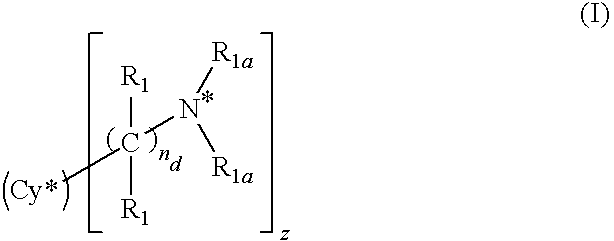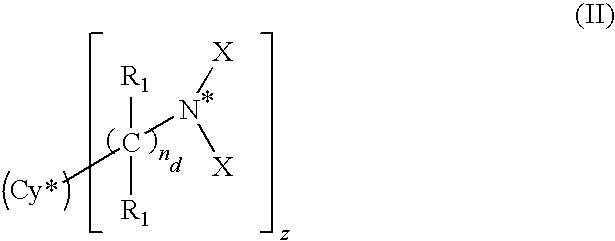Amine condensation polymers as phosphate sequestrants
a technology of phosphate sequestration and condensation polymer, which is applied in the direction of anti-noxious agents, drug compositions, and metabolic disorders, can solve the problems of invasive nature of dialysis, severe abnormalities in calcium and phosphorus metabolism, and inability to adequately reverse hyperphosphatemia
- Summary
- Abstract
- Description
- Claims
- Application Information
AI Technical Summary
Benefits of technology
Problems solved by technology
Method used
Image
Examples
example 1
Synthesis of tris(2-aminoethyl)amineepichlorohydrin (1:1) Condensation Polymer
[0149]To a solution of tris(2-aminoethyl)amine (22.42 mL) in methanol (35 mL) under nitrogen was added epichlorohydrin (11.73 mL). Upon addition of the epichlorohydrin the reaction exothermed to 74° C. After the exotherm subsided, the solution was heated to reflux (temperature setting of 75° C.) for 24 h. During this period the reaction turned from a solution to a block gel. After cooling to room temperature, the block gel was broken into small pieces with a potato masher, and suspended in methanol (500 mL). After stirring for at least 30 minutes, the suspension was filtered. The polymer was similarly washed twice more with methanol. The polymer was then suspended in deionized water (500 mL), stirred for at least 30 minutes, and filtered. The polymer was suspended again in deionized water (500 mL), stirred for at least 30 minutes. The pH of the suspension was adjusted to 7 with the addition of concentrated...
example 2
Effects of Amine Condensation Polymers for Reducing Urinary Phosphate Levels
[0151]House male Sprague Dawley (SD) rats were used for the experiments. The rats were placed singly in wire-bottom cages, fed with Purina 5002 diet, and allowed to acclimate for at least 5 days prior to experimental use.
[0152]To establish baseline phosphorus excretion, the rats were placed in metabolic cages for 48 hours. Their urine was collected and its phosphorus content analyzed with a Hitachi analyzer to determine phosphorus excretion in mg / day. Any rats with outlying values were excluded; and the remainder of the rats were distributed into groups.
[0153]Purina 5002 was used as the standard diet. The polymer being tested was mixed with Purina 5002 to result in a final concentration 0.5% by weight. Cellulose at 0.5% by weight was used as a negative control. For each rat, 200 g of diet was prepared.
[0154]Each rat was weighed and placed on the standard diet. After 4 days the standard diet was replaced with...
PUM
| Property | Measurement | Unit |
|---|---|---|
| temperature | aaaaa | aaaaa |
| temperature | aaaaa | aaaaa |
| structure | aaaaa | aaaaa |
Abstract
Description
Claims
Application Information
 Login to View More
Login to View More - R&D
- Intellectual Property
- Life Sciences
- Materials
- Tech Scout
- Unparalleled Data Quality
- Higher Quality Content
- 60% Fewer Hallucinations
Browse by: Latest US Patents, China's latest patents, Technical Efficacy Thesaurus, Application Domain, Technology Topic, Popular Technical Reports.
© 2025 PatSnap. All rights reserved.Legal|Privacy policy|Modern Slavery Act Transparency Statement|Sitemap|About US| Contact US: help@patsnap.com



